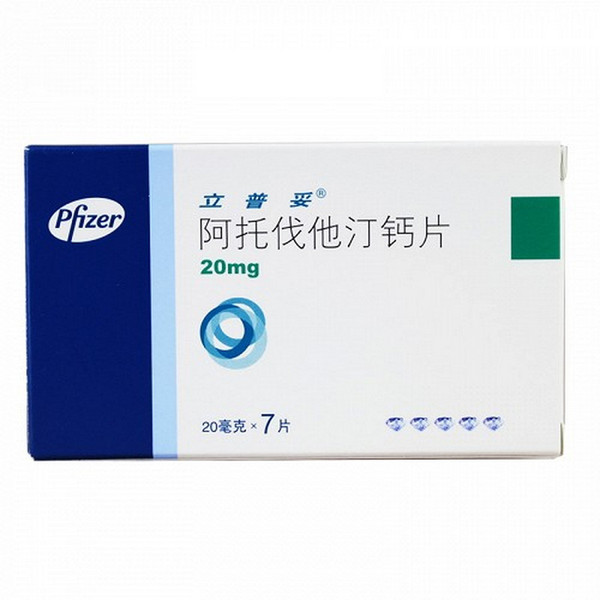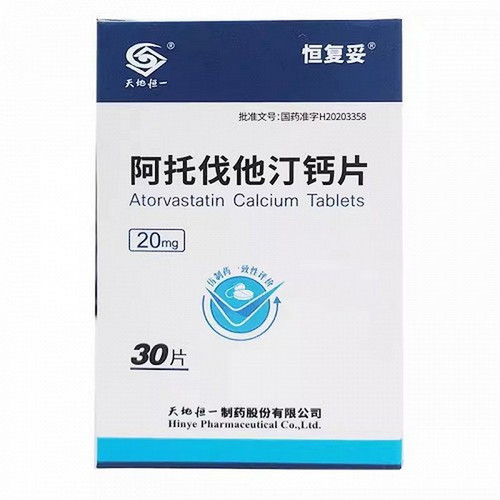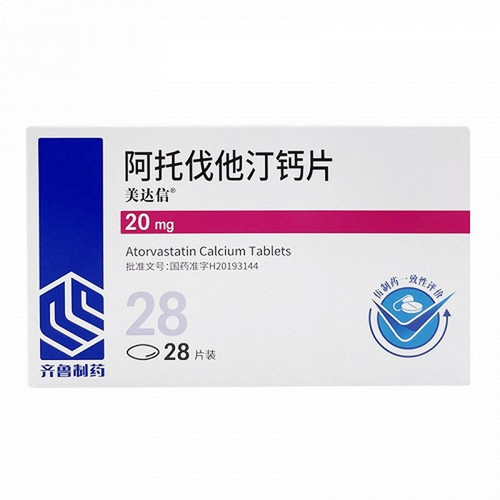Product Overview
[Drug Name]
Generic Name: Atorvastatin Calcium Tablets
Trade Name: Lipitor Atorvastatin Calcium Tablets 20mg x 7 tablets
[Main Ingredients]
Each tablet contains atorvastatin calcium equivalent to 10mg of atorvastatin.
[Appearance]
This product is a white, oval, film-coated tablet.
[Indications/Main Functions]
1. Hypercholesterolemia: This product is indicated for the treatment of elevated total cholesterol (TC), low-density lipoprotein cholesterol (LDL-C), apolipoprotein B (Apo B), and triglycerides (TG) in patients with primary hypercholesterolemia, including familial hypercholesterolemia (heterozygous type) or combined hyperlipidemia (equivalent to Fredrickson types IIa and IIb), who have not responded satisfactorily to dietary therapy and other non-drug therapies. In patients with homozygous familial hypercholesterolemia, atorvastatin can be used in combination with other lipid-lowering therapies (such as LDL plasma dialysis) or alone (when other treatment options are unavailable) to lower TC and LDL-C. 2. Coronary Artery Disease: In patients with coronary artery disease or coronary artery disease-related critical illnesses (such as diabetes, symptomatic atherosclerotic disease) combined with hypercholesterolemia or mixed dyslipidemia, this product is indicated for: reducing the risk of non-fatal myocardial infarction, fatal and non-fatal stroke, revascularization, hospitalization for congestive heart failure, and angina.
[Precautions]
1. Atorvastatin is contraindicated in patients with allergies to atorvastatin. Use with caution in patients with allergies to other HMG-CoA reductase inhibitors. 2. Atorvastatin is contraindicated in patients with active liver disease or persistently elevated serum aminotransferases of unknown cause.
[Drug Interactions]
1. Active liver disease, including persistently elevated liver aminotransferases of unknown cause. 2. Known hypersensitivity to any of the ingredients in this product. 3. Pregnancy: This product is contraindicated for use by pregnant women or women of childbearing potential who may become pregnant. This product may cause fetal harm when used by pregnant women. Serum cholesterol and triglyceride levels are elevated during normal pregnancy, and cholesterol or cholesterol derivatives are essential for fetal development. Atherosclerosis is a chronic disease process; therefore, discontinuing lipid-lowering medication during pregnancy in patients with primary hypercholesterolemia has minimal effect on the long-term outcome of atherosclerotic disease. Adequately controlled studies of atorvastatin use in pregnant women are lacking; however, there have been occasional reports of congenital anomalies in fetuses exposed in utero to statins. Reproduction studies in rats and rabbits have not demonstrated evidence of teratogenicity with atorvastatin. Lipitor should be prescribed to women of childbearing potential only if conception is extremely unlikely and the patient has been informed of the potential risk. If conception occurs while taking this drug, the drug should be discontinued immediately, and the potential risk to the fetus should be considered (see [Use in Pregnant and Lactating Women]). 4. Breastfeeding Women: It is unknown whether atorvastatin is excreted in human breast milk; however, other drugs in this class are secreted in breast milk in small amounts. Because statins may have potentially serious adverse reactions in breastfeeding newborns, women taking this drug should not breastfeed (see [Use in Pregnant and Breastfeeding Women]).
[Pediatric Use]
This drug should only be used in children by a specialist. Therapeutic experience with this drug in children is limited to a small number of patients (aged 4 to 17 years) with severe lipid disorders, such as homozygous familial hypercholesterolemia.
[Elderly Use]
The efficacy and safety of atorvastatin calcium at the recommended dose in patients aged 70 years and older are no different from those in the general population.
[Pregnant and Breastfeeding Use]
Because animal studies have shown that this drug can cause fetal developmental impairment, and its excretion in breast milk is unknown, its use in pregnant and nursing mothers is not recommended.
[Specifications]
20mg*7 tablets (Liputuo)
[Dosage and Administration]
Patients should follow a standard low-cholesterol diet before starting treatment with this drug and maintain a healthy diet throughout treatment. The dose should be individually adjusted based on baseline LDL cholesterol levels, treatment goals, and the patient's response to treatment. The usual starting dose is 10 mg once daily. Dose adjustments should be made every four weeks or longer. The maximum dose is 80 mg once daily. Lipitor can be taken at any time of day, regardless of mealtime. For patients at low risk for cardiovascular events, the treatment goals are LDL-C <4.14 mmol/L (or <160 mg/dL) and total cholesterol <6.62 mmol/L (or <240 mg/dL). For patients at moderate risk, the treatment goals are LDL-C <3.37 mmol/L (or <130 mg/dL) and total cholesterol <5.18 mmol/L (or <220 mg/dL). The treatment goals for high-risk patients are LDL-C <2.59 mmol/L (or <100 mg/dL) and total cholesterol <4.14 mmol/L (or <160 mg/dL). The treatment goals for extremely high-risk patients are LDL-C <2.07 mmol/L (or <80 mg/dL) and total cholesterol <3.11 mmol/L (or <120 mg/dL). Excerpted from "Guidelines for the Prevention and Treatment of Dyslipidemia in Adults in China" in the Chinese Journal of Cardiology, Vol. 35, No. 5, pp. 390-431, 2007. Treatment of Primary Hypercholesterolemia and Combined Hyperlipidemia: Most patients can control their lipid levels with atorvastatin calcium 10 mg once daily. Significant efficacy is seen within 2 weeks of treatment, and significant efficacy is seen within 4 weeks. Efficacy is maintained with long-term treatment. Treatment of Heterozygous Familial Hypercholesterolemia: The initial dose for patients is 10 mg daily. Individualized dosing should be followed, and the dose should be gradually adjusted every four weeks to 40 mg daily. If satisfactory efficacy is still not achieved, the dose can be adjusted to a maximum of 80 mg daily or 40 mg of this product can be used in combination with a bile acid chelate. Homozygous familial hypercholesterolemia: In a charitable study of 64 patients, 46 of whom had confirmed LDL receptor information. The average LDL-C level in these 46 patients decreased by 21%. The dose of this product can be increased to 80 mg daily. Treatment of homozygous familial hypercholesterolemia: In a charitable study of 64 patients, 46 of whom had confirmed LDL receptor information. The average LDL-C level in these 46 patients decreased by 21%. The dose of this product can be increased to 80 mg/day. For patients with homozygous familial hypercholesterolemia, the recommended dose of this product is 10-80 mg daily. Atorvastatin calcium should be used as an adjunct to other lipid-lowering therapies (such as LDL plasma dialysis). Or, when these treatment options are unavailable, this drug can be used alone. Dosage for Patients with Renal Insufficiency: Renal disease does not affect the plasma concentration of this drug or its lipid-lowering effects, so no dosage adjustment is required.
[Adverse Reactions]
1. The most common adverse reaction to this drug is gastrointestinal discomfort; others include headache, rash, dizziness, blurred vision, and taste disturbances. 2. It may occasionally cause a reversible increase in serum aminotransferases. Therefore, liver function should be monitored. 3. Rare adverse reactions include impotence and insomnia. 4. Rare adverse reactions include myositis, myalgia, and rhabdomyolysis, manifesting as muscle pain, fatigue, fever, and accompanied by elevated blood creatine phosphokinase and myoglobinuria. Rhabdomyolysis can lead to renal failure, but this is rare. Concomitant use of this drug with immunosuppressants, folic acid derivatives, niacin, gemfibrozil, erythromycin, etc. may increase the risk of myopathy. 5. Hepatitis, pancreatitis, and allergic reactions such as angioedema have been reported.
[Contraindications]
1. Active liver disease, including persistently elevated liver transaminases with unexplained causes. 2. Known hypersensitivity to any of the ingredients in this product. 3. Pregnancy: This product is contraindicated for use by pregnant women or women of childbearing potential who may become pregnant. This product may cause fetal harm when taken by pregnant women. Serum cholesterol and triglyceride levels are elevated during normal pregnancy, and cholesterol or cholesterol derivatives are essential for fetal development. Atherosclerosis is a chronic disease process; therefore, discontinuing lipid-lowering medication during pregnancy in patients with primary hypercholesterolemia has minimal effect on the long-term outcome of atherosclerotic disease. Adequately controlled studies of atorvastatin use in pregnant women are lacking; however, there have been occasional reports of congenital anomalies in fetuses exposed in utero to statins. Reproduction studies in rats and rabbits have not shown any evidence of teratogenicity with atorvastatin. Lipitor should be prescribed to women of childbearing potential only if they are unlikely to conceive and have been informed of the potential risks. If a patient becomes pregnant while taking this medication, discontinue the drug immediately and consider the potential hazard to the fetus (see [Use in Pregnant and Lactating Women]). 4. Breastfeeding Women: It is unknown whether atorvastatin is excreted in human breast milk; however, other drugs in this class are secreted in breast milk in small amounts. Because statins may have potentially serious adverse reactions in nursing newborns, women taking this drug should not breastfeed (see [Use in Pregnant and Lactating Women]).
[Overdose]
There is no specific treatment for overdose with this drug. In the event of an overdose, patients should receive symptomatic and supportive measures as needed. Liver function and serum creatine phosphokinase levels should be monitored. Because a large amount of the drug is bound to plasma proteins, hemodialysis does not significantly accelerate the clearance of atorvastatin.
[Pharmacology and Toxicology]
This drug is a statin, a lipid-regulating drug and an HMG-CoA reductase inhibitor. While inactive, its hydrolysis products after oral absorption competitively inhibit hydroxymethylglutaryl-CoA reductase, the rate-limiting enzyme in cholesterol synthesis, reducing cholesterol synthesis and increasing low-density lipoprotein receptor synthesis. Its primary site of action is in the liver, resulting in lower blood cholesterol and LDL cholesterol levels, moderately lowering serum triglyceride levels, and increasing high-density lipoprotein levels. This has a preventive and therapeutic effect on atherosclerosis and coronary heart disease.
[Pharmacokinetics]
This drug is well absorbed orally. Due to extensive first-pass metabolism in the liver, its absolute bioavailability is low, approximately 12%. It is metabolized in the liver via cytochrome P450 3A4 to various active metabolites. The mean plasma half-life of atorvastatin is approximately 14 hours, but due to the effects of its active metabolites, the actual half-life of its HMG-CoA reductase inhibition is 20-30 hours. This drug is 98% protein-bound, with the majority excreted in the bile as metabolites.








